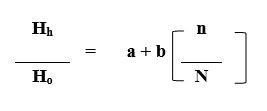The extent of solar resources in Sri Lanka has been estimated in the past based on a study of the daily total direct sunshine hours recorded at a number of weather and agricultural stations throughout the country. These data have been applied to the well-known Angstrom relationship in order to obtain an estimate of the distribution of monthly average daily total solar resources at these stations. Various climate models have been developed for use in predicting the monthly average global solar radiation, the popular one being the Angstrom-type regression equation developed by Angstrom in 1924. This relates to monthly average daily global radiation to the average daily sunshine hours, and is given by the following expression:
kWh·m-2·day-1 across the country, where the lowest values occur in the hill country of the south-central region. The results also showed that the country does not experience sharp seasonal changes in solar resources. (Solar Resource Assessment for Sri Lanka and Maldives)
Figure 01 shows the Electrical energy production during one-year period of a 5.5kWp plant in Hambanthota area.In Sri Lanka, agricultural process consists of several major steps which have to pay more attention very carefully. Irrigation is one of the major and complex processes in agriculture. During the irrigation periods large of amount of energy is used. The economy of Sri Lanka still depends on the agriculture. Usually farmers in dry zone face lot of problems while irrigating their crops. Most of the time, they use conventional methods such as canals, wells and engine driven pumps using petroleum fuel to irrigate their crops. Sources for such irrigation are rain fall, petroleum and man power. Farmers could not rely on rain fall owing to its uncertainty. According to the past records, rainy seasons and the amount of rain have been changed. Sometimes they experience a very long period of dry season, thus being unable to use water from canals or rivers. The other method of irrigation is done using engine driven motor pumps. Fuel for those engine driven pumps are basically kerosene and diesel. Conventional systems like Diesel or Kerosene water pump systems have high running and maintenance costs even the capital cost is low. Also the increasing price of petroleum fuel has reduced the profit margin to be gained by farmers from irrigation, since food prices have generally been prevented from rising in line with energy costs. The cost of manpower also is in the positive trend which will also contribute to the cost of production.
Therefore, operating an irrigation system using solar energy would be an attractive solution for conventional irrigation methods which are commonly used in Sri Lanka. Also, this would be the best solution for the energy crisis which will impact with the irrigation.
Further Readings
- George R.,Heimiller D., Marion B., Renné D.(National Renewable Energy Laboratory) and Gueymard C. (Solar Consulting Services) (August 2003):Solar Resource Assessment for Sri Lanka and Maldives.
Continued to : Solar Energy for Irrigation of a Developing Country Like Sri Lanka Contd.



